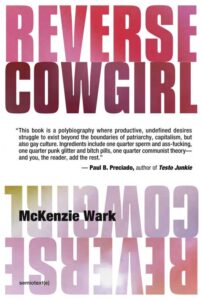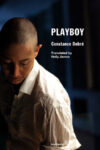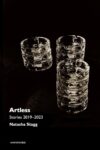
[Semiotext(e); 2020]
McKenzie Wark’s experimental autobiography, Reverse Cowgirl, begins not with a birth, as these kinds of book generally do, but with a death: the death of her mother when she was six years old. So the book begins with an absence. This experience will mark her life during the 70s and 80s, when she was growing up in Australia, before her move to New York at the beginning of the new century. For Wark, what emerges during her sexual experiences is a desire to non-exist, to blackout, to eventually erase her gender as a male, and to question what it means to be human: “This is the problem with being human. We exist for each other only when we don’t exist; and we don’t exist for each other only in those moments of raw existing. We are monsters of existence, and non-existence. That is all.” This book will chronicle Wark’s attempt to find a form of life outside the conventions of trans experience. Throughout the book, Wark uses quotes from straight, gay, and lesbian poets, writers, cultural theorists, and feminists to add a kind of commentary on the text. She creates a mosaic, an intertextual weave, a dialogue. She calls it her “chorus.” Ultimately, Reverse Cowgirl attempts to examine who a trans woman is before she transitions.
For Wark, there is a central problem associated with existence as a male and so she desires “to make up a being so as not to exist.” An aspect of this is performative: “There was a stretch of the seventies when clothes, hair, style — all of those things were unisex. All through that time, I dressed like a girl.” Wark quotes Otto von Bush:
Fashion is feral, it is that of the animal. Even if the culture industries and ‘techniques of the self’ attempt to domesticate, control and commoditize the forces of fashion, in essence fashion remains a living thing, always with the potential of breaking free of its commodity form. Fashion is not a thing, it is not bound to clothes or goods, but it is a place you can go, an emotional space you enter inside yourself and another.
Drag allows Wark to “slip between genders, shimmy past masculinity for a moment, but not really launch into another gender; it was more a euphoria of lofting out of gender for a moment, composing some other body outside of gender’s gravity. To non-exist in a non-existing gender, to float a femme phantasmagoria of skins and signs.” Fashion is a way to create a spectacle that hides the absence, clothing the void. But fashion is also ultimately a kind of compromise, “a holding pattern in genres and genders, skins and signs. Holding what?” At this early point in the book, the question of gender still remains undetermined.
In reading Reverse Cowgirl, I was reminded of how adopting one gender seems so important to the medical and psychiatric community (and to far right morons like Ben Shapiro and Jordan Peterson). For Wark, it seems “the fabric of the space-time continuum hinged on me being decidedly one or the other.” She quotes Judith Roof: “What genders do: they provide the registers through which individuals can resolve the relation between psychical and social systems, finding vectors of desire and identification that persistently resolve lack and difference and by which these drives find purchase.” Her gender is transitional and cannot be defined as one gender or another. It is like a black hole, sucking in all the light. More Dionysian then Apollonian. I’m reminded of the Dionysian mysteries and the intoxicants and trance inducing techniques (such as dance and music) that were used to destroy inhibitions and social constraints, and to liberate the individual.
Wark constructs this provisional gender based on her lover Edward’s. She is “not quite called into being by his [Edward’s] quite explicit needs and desires.” The problem is a linguistic one: there is no reference point in language that could define this transitional gender, which is not actually a gender at all. For Wark, when one slips out of the male gender one becomes a thing that is not clearly defined by the medical community or legal community or society. A sense of self vanishes. But how can one build an architecture of the self, when any attempt sees it consistently disappear as a kind of flicker at the periphery of things? How can one experience a sensation in the flesh that makes one conscious of a body? For Wark, to be fucked is to “become flesh.” She quotes Maggie Nelson: “I am not interested in a hermeneutics, or an erotics, or a metaphorics, of my anus. I am interested in ass-fucking.” In the absence of gender, the body is still present, to be prodded, used, turned over, penetrated. For Wark, being penetrated is the beginning of her realization of “a being I could call I”: “Edward’s cock would press my insides against their boundaries, pushing what would become, when pressed, against skin from the inside, a being I could call, a being I could call I. This coming into being, this inside out subjectivity, would change things between us.”
Since Edward “tolerated [Wark’s] femme affectation,” she is able to subvert the role of the dominant heterosexual male. As a result, she lies outside a definable gender role and during sex, she is reduced to a body, that is all: “At best, it wiped me clean, reduced under his mouth and hands to fluttering flinching flesh, devoid of subject, gender, identity. Just being. For a moment at least. How hard it is to stay outside of one’s self,” i.e. one’s self as a male. For Wark, being penetrated allows her to feel “opened up to the emptied spaces of other being, became a mere skin of receptors to its whims.” As the male body subverts its learned gestures, language, and sexuality, an imaginative space opens where it can be conceived of as almost without limit in terms of its possibilities for pleasure; it becomes trans-human, and transcends the male. She quotes Aime Cesaire: “One of the values invented by the bourgeoisie in former times and launched throughout the world was man — and we have seen what has become of that.”
For Wark, there is a point where the male gender is drained of meaning, and only a body exists; the skin no longer seems real or even human. For her it seems as though it “might split open and disgorge some mutant pupae.” So the body is potentially monstrous, as it remains undefined, undocumented, feral; animalistic rather than human. It migrates across borders of identity and gender, subverting male defined territories, defying gravity, space and time; the male gender is as if vaporized in a black hole and the body is turned inside out. Wark describes it this way: it is “disappearing into waves refracting on waves of data-foam, sensation of neither pleasure nor pain but of raw need to not be, to rage, to rile, to upend all the coordinates of a self in the body.” The penetrated male unlocks a monstrous, alien, mutant, cyborg: a trans-human, non-gendered space. She quotes Donna Haraway:
Monsters have always defined the limits of community. The Centaurs and Amazons of Ancient Greece establish the limits of centered male polis of the Greek male human by their disruptions of marriage and boundary pollutions of the warrior with animality and woman. Cyborg monsters define quite different possibilities from those proposed by the mundane fiction of Man and Woman. A cyborg body does not seek unitary identity, it takes irony for granted. One is too few, and two is only one possibility. Intense pleasure in skill, machine skill, ceases to be a sin, but an aspect of embodiment.
After her relationship with Edward she meets John, a patron of the theater, who exists in a world of upper-class gays and aesthetes; here she learns about class through the way she was looked down upon and barely tolerated. John, a rich gay man, treats her as a straight man might treat a woman: “I was the handbag. I was the girl. This was quite educational. I was not expected to talk, except for the purpose of social graces. I was not supposed to have opinions about things”; Wark writes: “That was an all-stag world, and one where his [John’s] homosexuality was simply overlooked.” For Wark, the clone in Gay Culture during the seventies, exposed similar tendencies:
It seemed like they were trying to be more masculine than straight men. If straight men imagined they were above the women they fucked, then the clones would be above those men by fucking other men instead. On the logic that if you fuck it then you are above the thing fucked. Fucking men who were femme does not fulfill this feat of the overman. As everybody supposedly knows, us faggots are even less than women. Plenty of straight women would agree, and sad to say so too would some lesbians. The non-straight world was not free of its obsessive ranking and sorting. It was not communism. I wanted to destroy all of this.
The gay world simulates the straight world here; gendered bodies simulate and perpetuate the roles of male and female in the straight world and from this is born the idea of the family and their consequent faith in God as a foundation; furthermore, the Abrahamic religions deny the raw animal drives of the body and attempt to sublimate them. For Wark, even the erotic became tinged with the sacred: “Some of you read a little too much Georges Bataille in the late eighties. Got a bit carried away with the sacred side of the erotic ritual. Sometimes it was just mammals rutting.” For Wark, the thinking “I” must be separated from the body. The feral body = ecstatic extremes that deny the individuality and primacy of the self, the ego. Wark quotes Frank Moorhouse: “How hyper-charged life is when it breaks out of propriety. I was sorry, as I trembled there against his legs, for those people with well-behaved love. How good it was to have one’s integrity utterly infringed, to be the trembling, crushed, infringed self.”
Throughout the 90s, she lived with several women. The transition is seemingly back to the male gender but this relationship is complicated by Wark’s sense of her position in relation to the woman and her sense of a literature written by men:
Nobody needs to read another story by a man about, well, anything. Certainly not another story where the man fucks the woman. So let’s just keep it to this not-novel but less storied dilemma: how does a man whose peak sexual experiences all involved being fucked in the ass go about having sex with a woman.
Perhaps, “the man in this story, who fucks the woman, is maybe not a man after all?” When having sex with a woman, Wark imagines herself as a woman being fucked and so she learns to be “a straight man fucking by listening to my inner girl.” She continues: “But in the rub, the selves disappear anyway. They don’t exist. For a moment it all merges into a particular and fleeting splash into time of the eternal animal.” She quotes Bataille: “The tiger is to space as the sex act is to time.” For Wark, the “I” becomes the multiple “We,” without identity or gender, and the human, separating thoughts from the body, becomes “the eternal animal,” experiencing “the instant joy of millennia past.”
Near the end of the book, Wark realizes her focus on non-existence when she was younger contained something else, was something else:
a dysphoria: a warp, a skew, a twisted strand. Within the need to not exist, a need to exist, but otherwise. The femme body, that I that is another, welled back up to the skin, the surface, and insisted that it stay there. Rather than non-exist as human on a part time basis, to transition to existing, all the time, as something that would no longer be pretending to be a man . . . to be human is to be and not to be, to be impossible, a folly.
She is now out as trans. But who is a trans woman before she transitions? For Wark, the realization of being trans begins with a need to not exist, which, in fact, masks a need to exist but otherwise. There is a sense of absence in the body that cannot be explained. Drugs and sex allow the body to feel at ease but Wark’s failed attempts at both a gay and a straight lifestyle signal that these labels don’t fit her sense of herself as trans. Furthermore, it’s clear, in our time, that the established narratives for being trans are not sufficient. A new language must be created because the male language no longer applies. This is the linguistic revolution we need now. For Wark, she “will have to figure out how to speak another language of the body.” This book contains passages that show exactly that, a new kind of writing about the trans body, that is both sexual and poetic: “just dying to be fucked, to be peeled and shucked and reamed inside/out until there is nothing but the body unraveled as one endless skein, a wicker-weave just wanting to tangle, to be fricked and unbraided until it catches fire.” Wark’s body has crossed over to a difference space and time; she is like a nomad on the event horizon, a navigator at the peripheries of meaning, real and yet unreal, visible and yet invisible, a surface of unfolding and folding skin in the space-time continuum. Wark will no longer pretend to be a man.
In the present time where gender, sexuality, identity and language have been questioned, and problematized, McKenzie Wark’s Reverse Cowgirl is a central text in the ongoing argument of what it means to be trans. It is “more meme than memoir. Not a personal essay so much as an impersonal assay . . . it’s not about coming of age, it’s about the age of cum. It is not entirely factual.” It’s a book that contains a lot of fucking; at one point, Wark advises the reader to fold up the book and make a tube out of it, like an anus, and to penetrate it! So it’s also a book to fuck! Wark continues: “It might however be a book about sexual veracity. If something gets hard, or cums, or doesn’t, that at least probably happened. It was probably more sublime ridiculous beautiful ugly than described.” Reverse Cowgirl is an important book that challenges the medical and psychiatric communities’ idea of a fixed gender and the present conservative push against the right for gays, lesbians and trans people to exist freely in society; and it does this by examining a form of life that exists outside the boundaries of accepted versions of trans experience.
Peter Valente is a writer, translator and filmmaker. He is the author of eleven full length books, including a translation of Nanni Balestrini’s Blackout (Commune Editions, 2017), which received a starred review in Publisher’s Weekly. His most recent book is a co-translation of Succubations and Incubations: The Selected Letters of Antonin Artaud 1945-1947 (Infinity Land Press, 2020). Forthcoming is a book of essays, Essays on the Peripheries (Punctum Books, 2020), and his translation of Nicolas Pages by Guillaume Dustan (Semiotext(e), 2022). Twenty-four of his short films have been shown at Anthology Film Archives. He is presently working on editing a book on the filmmaker Harry Smith.
This post may contain affiliate links.







